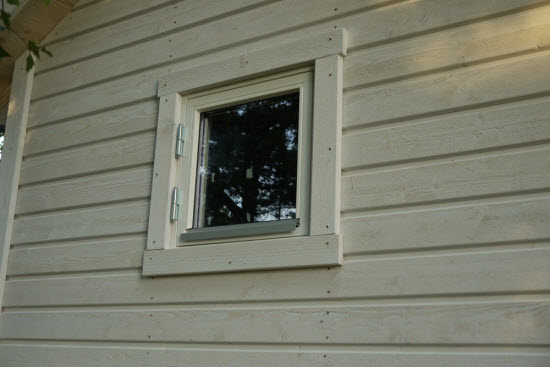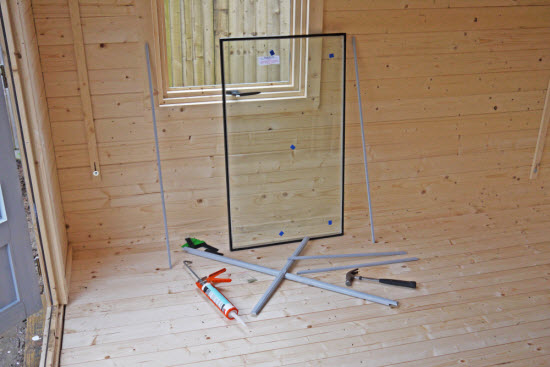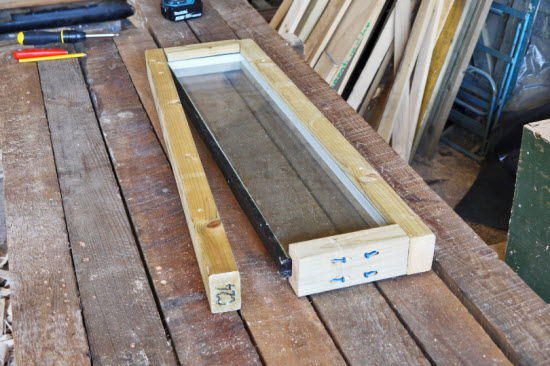Choosing shed windows to let the light into your shed (but not the burglars!)
Shed windows are essential to let natural light into your shed so that you can see your lawn equipment, tools or whatever you use the backyard shed for.
Every day we look through a house, garden shed or office window but give very little thought to how the window frames are made, how they fit within the structure of the building or even the options that are available for the glazing.
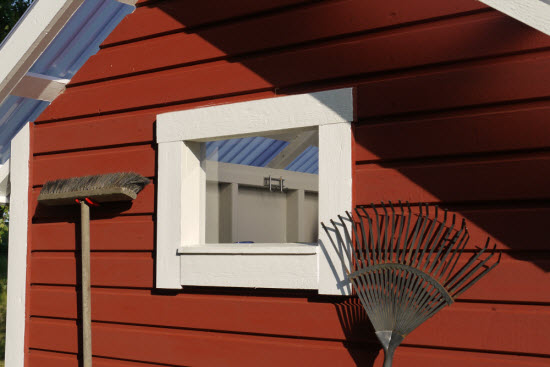 Nice looking small shed window in a gable wall
Nice looking small shed window in a gable wall
If you are building a new shed there are a lot of options to think about. Should it be double glazed, single glazed? What is the difference between toughened glass and horticultural glass? Is plastic fantastic or should you stick with traditional glazing types?
Let's take a look at various window styles and the sorts of materials and options that are open to you.
The four main areas we are going to look at are:
Garden shed window frame materials. Including timber, plastic and metal
Glazing material. Is glass or plastic better?
Window treatments Shutters, blinds, insect screens etc.
Before we move on to the various window frame materials and types of glazing be sure you are clear on how you want your windows to perform and why you want them in your shed.
1.0 Essential design elements for your shed windows
Because you don't necessarily need the same level of performance from a shed window as a house window it opens up many options that you might not have considered. The windows aren't restricted to a certain percentage of the wall area, they don't need to be as high specification in terms of thermal performance or ability to keep out draughts. This lack of restriction means that you have a much wider range of material choice and gives you much more freedom to create the window style that you want.
However there are three very practical factors that will govern your important decision over shed window style: Light, Ventilation and Security
Light
It is important to let lots of natural light into your shed so that you can easily find what you want. The size and window placement affect the amount of light.
Windows placed higher up will get more light, as will windows that face towards less shaded areas. Be a bit careful about facing windows directly South (in the Northern hemisphere) as you may find the interior of the shed will heat up too much.
The window location may be governed by a required view out of the shed across the garden, or by the requirement for plenty of light to warm young seedlings and encourage them to grow.
Ventilation
The requirement for good air flow is often a factor in new garden shed window selection. Opening windows allow you to ventilate the shed quickly and allow in lots of fresh air
This can be good for keeping the contents dry or to help control the temperature on hot days.
Choosing opening windows will enable you to control the flow of fresh air. Having the window on the opposing side to the door will enable you to get a cross flow of air.
It goes without saying that windows will need to open. Windows can be top hung, side hung or sliding. If you are going to have an openable shed window then make sure that it has easy access for you to be able to open it!
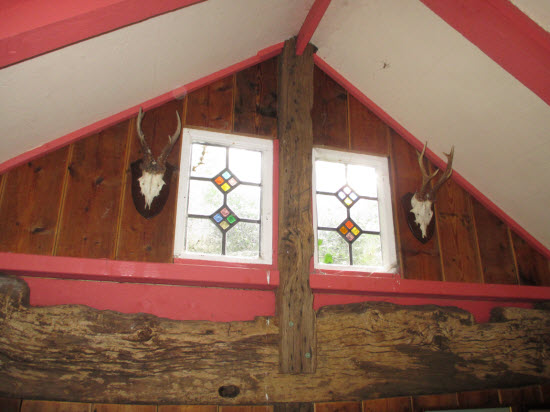 This stained glass shed window lets in light and adds a sense of beauty
This stained glass shed window lets in light and adds a sense of beauty
Security
Shed windows are a vulnerable point in your shed, there are a number of strategies that you can use to address security concerns:
Shed Security Windows
Narrow windows installed high up on a wall are a good way of allowing in light whilst restricting the view of the internal conents, they also maximise the use of internal wall space too.
Installing the windows at eaves level is one solution as in the picture below.
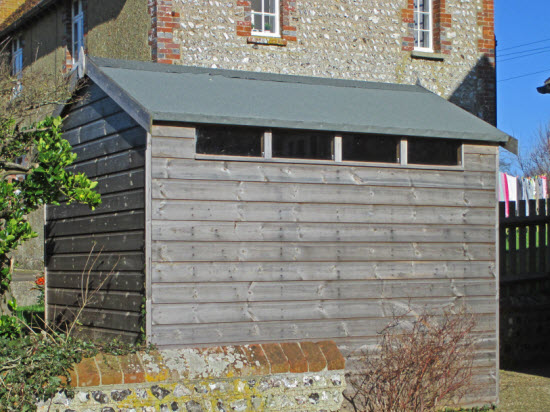 These non-opening shed security windows increase the protection for your belongings. But they do look a bit forbidding.
These non-opening shed security windows increase the protection for your belongings. But they do look a bit forbidding.
Door transom windows are another window placement that works well for security. The windows are high up, over the door, and so well place for available light.
Shed window film
Applying a translucent plastic film over a transparent window still allows in plenty of light but makes it impossible for an intruder to see the contents of the shed.
Shed window bars
Installing window bars or a sturdy wiremesh inside of the window will make it difficult for an intruder to gain access, even if they manage to break the window glass.
2.0 Garden shed window frame materials.
One of the first choices you will have to make concerning your windows will be what sort of material you want your window frames to be made from. The three main material choices for the window frame construction are: wood, PVC and metal.
Each of these materials have their own individual characteristics:
Wooden window frames
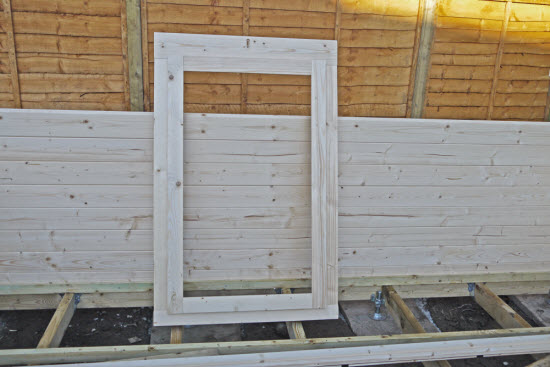 Timber shed window frame prior to installation in a log cabin shed
Timber shed window frame prior to installation in a log cabin shed
Wooden shed windows offer a huge range of flexibility from simple diy shed windows to sophisticated shop made stormproof windows. Wooden window frames look beautiful when properly treated or painted. If they are not they will become weather damaged in the longer term.
To help you on your way with wooden shed windows I have made this page to show you how to make simple wooden shed window frames.
PVC or vinyl windows
PVC window frames are often used as replacement windows in the UK. They are mainly chosen for durability and low maintenance. In terms of longevity they are quite good but at an environmental cost. However they are better than they used to be as PVC window frames can now be recycled.
PVC windows are often thrown away, so look for them in skips (dumpsters), renovation projects, ebay, gumtree and craigslist.
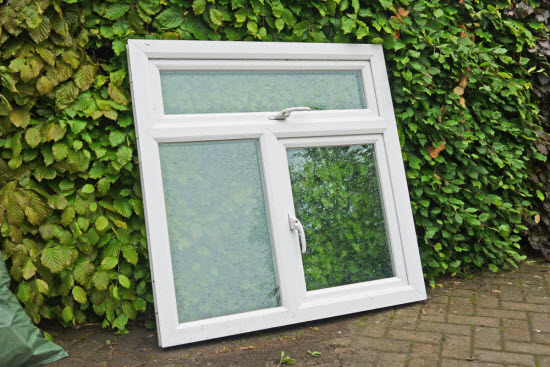 Pre-used double glazed vinyl windows
Pre-used double glazed vinyl windows
PVC window frames usually come in white or brown and don't need painting. The problem with PVC is that over time it can become brittle, fade and is not so environmentally friendly at the end of its life.
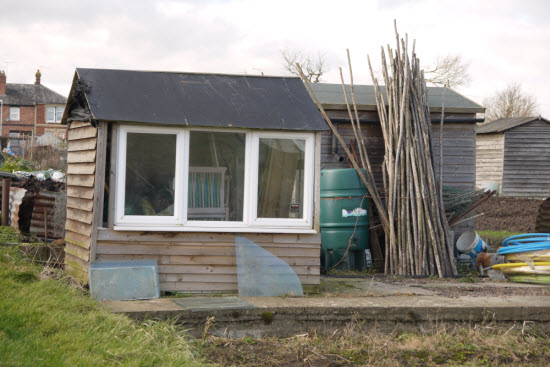 Small shed using pre-loved PVC window frames
Small shed using pre-loved PVC window frames
Metal - steel or aluminum shed windows
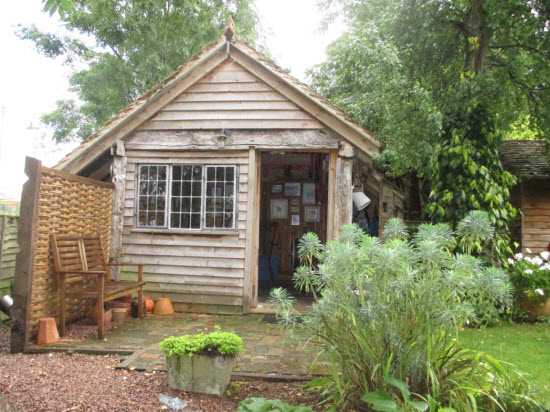 Pre-used metal window frames were used for this characterful shed
Pre-used metal window frames were used for this characterful shed
Metal shed windows are available with powder coated steel or aluminum window frames. These are a cheap, fairly basic design but just fine for a storage shed. Be aware that they are not a 'thermally broken' design that this means that you might end up with some condensation on the window frame if you are heating the shed in winter.
Aluminium is long lasting and does not rust easily. Aluminium windows are durable and can come in a variety of long lasting anodized finishes which give good corrosion resistance with little maintenance. Aluminium can be expensive but hey! this your shed you are building here so it could be worth it.
Suppliers in the US have a wide range of sizes and shapes from standard shapes, to transoms, arched and circular windows.
Each of these frame choices have their attractions as well as their drawbacks so it is a choice you will make based on your budget and the amount of upkeep you are willing to do.
3.0 Shed Window Glazing
Your next choice is the type of 'glass' you will use. Much of this choice is based on the intended use for your shed. The two main choices are glass or plastic window panes.
Types of Glazing
The range of glazing available to let light into your shed is wider than it would be for domestic windows.
Types of glazing include:
Glass windows
Horticultural glass - This is the thinnest most basic form of glass. It is typically 3mm thick. It can be cut into smaller panes by scoring it with a diamond cutter and then breaking it along the line. This benefit is partially counteracted by the relative weakness of horticultural glass. If hit by a ball or other object it shatters and the breaks into long dagger like shards.
Tempered or toughened safety glass - Much stronger than the horticultural glass. Also thicker at a minimum of about 4mm thick. Tempered glass is cut to the finished size and then heat treated and the edges polished to reduce the likelihood of cracking. If toughened glass is hit hard enough to shatter then it breaks into lots of tiny pieces. Which pose less of a hazard than the large shards of horticultural glass. However it needs to be ordered in standard size panes.
 Opening shed windw with tempered glass
Opening shed windw with tempered glass
Double glazed shed windows - Double glazed windows are most often made from toughened glass. The two panes are bonded together with either a slight vacuum or filled with an inert gas such as argon. You can order readymade windows for your shed in the same way as you would ordinary house windows.
 Double glazed unit about to be installed in wooden window frame
Double glazed unit about to be installed in wooden window frame
 One way of making your own shed window frame to accomodate a double glazed unit
One way of making your own shed window frame to accomodate a double glazed unit
You can also use recycled windows (frame and glass) that you recover from a refurbishment project. Or if you want to just use some recycled glass then it is fairly easy to remove the double glazed unit from these windows and make your own timber window frames to suit.
Plastic for shed windows
There are alternatives to the relative inflexibility of glass, these are acrylic and polycarbonate sheets. Both are types of plastic and have the advantage that in the types of thickness frequently used for shed windows (2-6mm), they are easy to cut using circular saws or routers. They both have excellent transparency 92 vs 88% (glass approx. 90%). One of the slight negatives for both is that they are less scratch resistant than glass and can become less transparent with age. To minimise scratching they should both be cleaned with soapy water rather than abrasive cleaners and avoid cleaning either with solvents at any cost as these will mark the surface.
One significant difference between the two types of plastic is the price. Cut price sheds use the thinnest material available which at 2mm is too flimsy and flexible.
Acrylic (Perspex/Plexiglas)
Acrylic shed windows are more scratch resistant and rigid than polycarbonate
Available in thicknesses of 2-30mm
Acrylic is cheaper than polycarbonate and is often supplied with low-end, mass-produced sheds.Polycarbonate sheet
Very impact resistant, so much so that it is used for bus shelters and police riot shields
Polycarbonate is stronger and more crack resistant than acrylic
Commonly used thicknesses for shed windows would be 3-4mm.Finally polycarbonate is more expensive than acrylic, probably about 40-50% more for the thicknesses involved for windows.
4.0 Shed window treatments
One last thing that you might consider when installing your windows is whether or not you will choose to install shutters, blinds or curtains. These are used to control the views into (and out of your shed) they can also help with heat loss/gain and improve security.
Shed window blinds or curtains
Main purpose is to keep out the sun or make cosy at night. They also help to restrict the view of contents from prying eyes.
They protect from the sun and provide security by obscuring the contents of the shed from outside viewing.
So what are your options for windows, for keeping light out and obscuring the view into/out of your shed
- Curtains -net curtains
- Blinds - venetian or roller blinds
- Frosting/obscured glass
- Shutters can provide security due to the fact that they can be closed and locked. They can also provide shade from the sun.
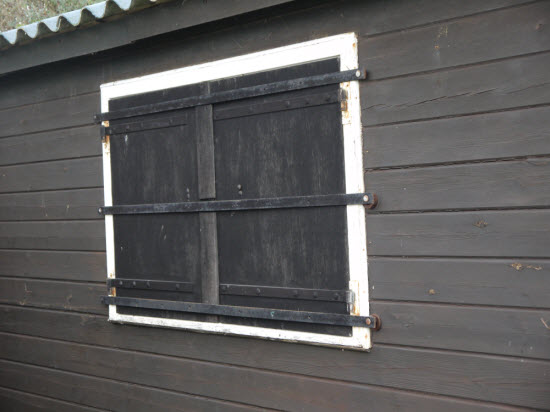 Hinged shed window shutters with security bars
Hinged shed window shutters with security bars
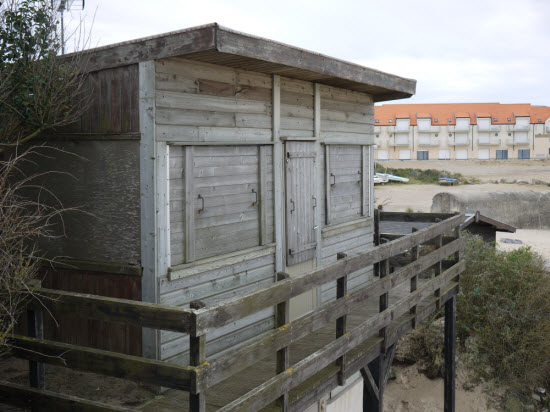 Removable shed window shutters secured from the inside
Removable shed window shutters secured from the inside
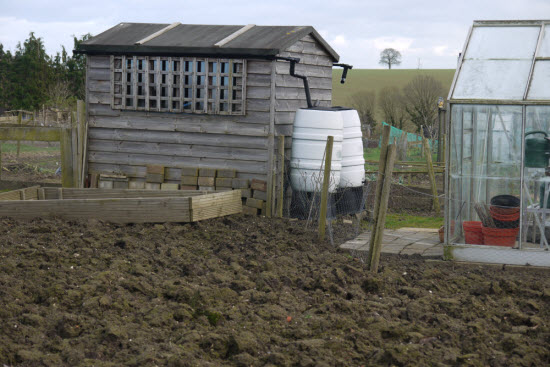 Installing trellis over the outside of this allotment shed window added somewhat to the security
Installing trellis over the outside of this allotment shed window added somewhat to the security
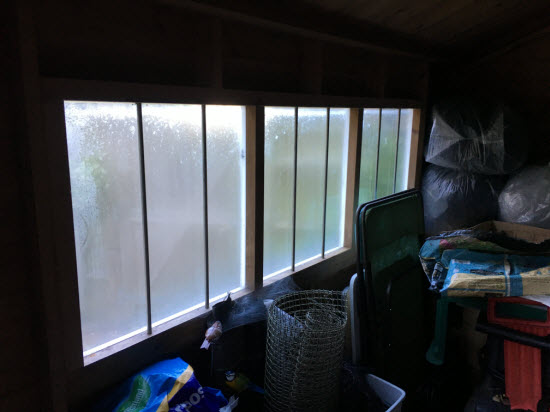 Vertical steel bars installed in the shed window frame improve security without overly affecting external appearance
Vertical steel bars installed in the shed window frame improve security without overly affecting external appearance
How to choose which shed window type is suitable for you?
I hope the above discussion has helped you to make a decision on the best type of window for your shed.
In my experience the the main decisions you need to make fit into the following categories.
Shed windows can be one of the most influential design elements of the shed, second only to the style of the roof. Sometimes it seems that when people set out to build their shed they pay a good bit of detail to everything except the windows. consider the fact that the windows can influence the look, feel and style of the shed.
Decide on use of building
heated vs. unheated
preferred window frame material
opening vs. non opening
premade,diy or recycled window
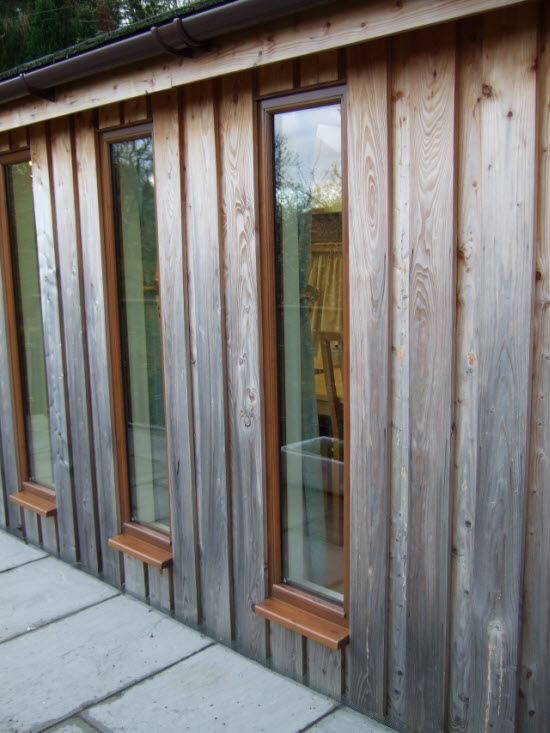 Fixed shed windows with board and batten siding
Fixed shed windows with board and batten siding
If all you are looking for a source of light, to be able to see out and ventilation is not too much of a concern then a fixed window may be exactly what you need.
For a simple window that looks nice but is more functional than beautiful then you might consider either a side hung or top hung casement.
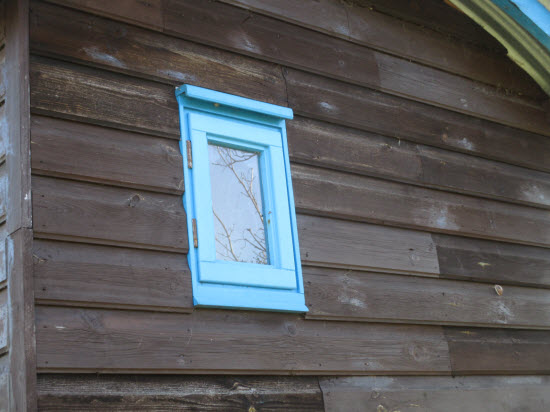 Nice little side opening shed window
Nice little side opening shed window
If you are looking for a beautiful looking window for your garden office shed then you might choose to install double hung sliding sash windows or horizontal sliding sash windows.
Choices for sourcing shed windows
- Ready made - Shed windows and more. House windows, builders merchant
- Recycled - skips, building projects, reclamation yards (though can be pricey nowadays)
- Make your own shed window frames

Keep in touch with our monthly newsletter
Shed Building Monthly
